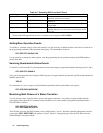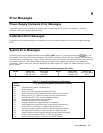
Compatibility Language 65
Table B-1. ARPS Commands (continued)
ARPS Command
1
Description Similar SCPI
Command
RST
This command resets the power supply if the output is disabled by
the overvoltage, remote inhibit, or foldback protection circuits.
The power supply resets to the parameters stored for the power-on
state. Note that the settings can be changed while the supply is
disabled.
OUTP:PROT:CLE
HOLD OFF
HOLD 0
HOLD ON
HOLD 1
These commands determine if certain newly received
commands are immediately acted on by the power supply
or are acted on later while the supply continues to operate with
previously received values. HOLD ON can be used to
synchronize power supply actions with the actions of other GPIB
devices. (See the TRG command.) Initial condition: HOLD OFF
VOLT:TRIG
CURR:TRIG
HOLD?
This command reads the HOLD setting.
VOLT:TRIG?
CURR:TRIG?
T
TRG
These commands cause the power supply to act on commands that
have been previously sent, but are being held (pending). The
supply continues to operate with previously received values until a
trigger command is received (see HOLD command.) The device
trigger interface message performs the same function.
INIT ON;TRIG
INIT ON;*TRG
STO RCL
These commands cause the power supply to store and recall power
supply states, except for output on/off. Each state includes:
voltage (lst and 2nd rank), current (lst and 2nd rank), soft voltage
and current limit, delay time, service request on/off, foldback (lst
and 2nd rank), mask (lst and 2nd rank), and hold.
Initial condition: Each register is initiated to the turn-on values.
*SAV
*RCL
STS?
This command reads the contents of the status register, which
maintains the present status of the power supply.
STAT:OPER:COND?
STAT:QUES:COND?
*ESE?
ASTS?
This command reads the contents of the accumulated status
register, which stores any bit condition entered in the status
register since the accumulated status register was last read,
regardless of whether the condition still exists.
STAT:OPER?
STAT:QUES?
*ESE?
UNMASK
mnemonics
UNMASK
xxx
These commands determine the conditions that will set bits in the
fault register, allowing the operator to define the conditions that
will be reported as faults. Fault conditions can be enabled by
sending a string of status register mnemonics after the UNMASK
command. The mnemonics must be separated by commas, and
may be sent in any order, but must correspond to the condition that
will be enabled. Fault conditions can also be enabled by sending
the decimal equivalent of the total bit weight of all conditions to be
enabled. UNMASK NONE disables all conditions from setting
bits in the fault register. Initial condition: UNMASK NONE
STAT:OPER:ENAB
STAT:QUES:ENAB
*ESE


















